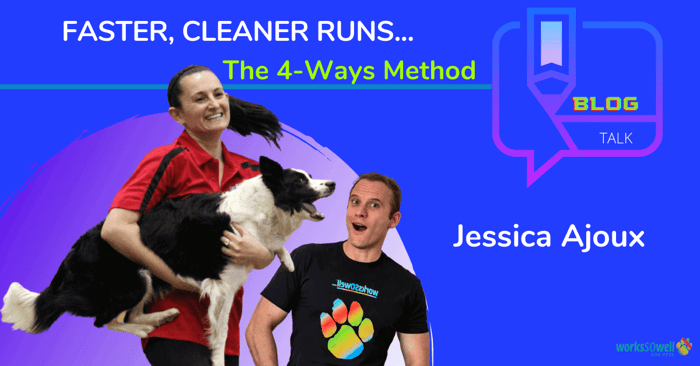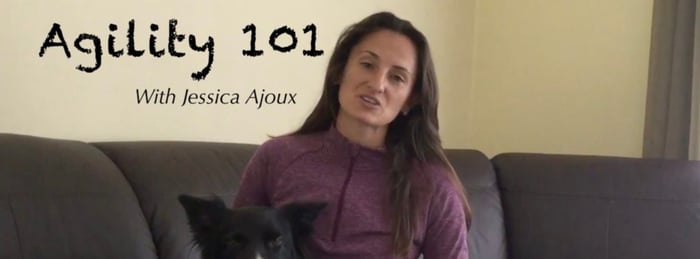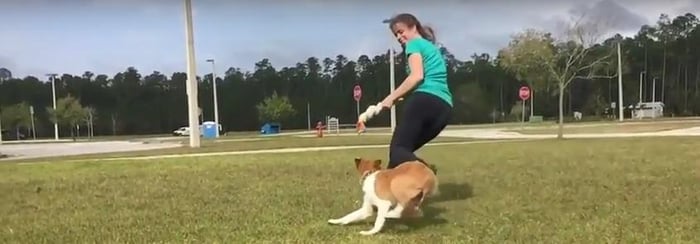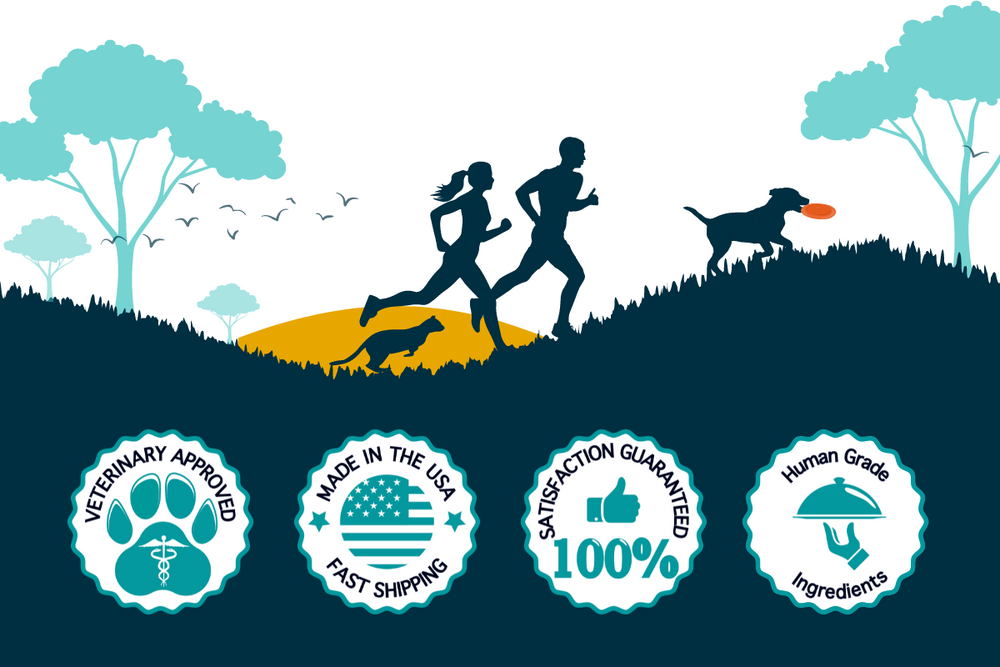Living Room Agility for Puppies and Beginners
What better time to start agility training your puppy! But where do you start? Do you need equipment? How can you train obstacles with no obstacles? And how often can you train? Jessica Ajoux, agility champion, taught us all the right ways to start training your agility star. Some of you may not know this, but Jessica is actually training her puppies right now, too!
Click below to watch the full live interview with Jessica
Training without Equipment
- The short answer is that you don’t need equipment to get started. That’s the finish line, not the starting point. There’s lots of foundation training to do first, and much can be done in your living room!
- Agility has two components: the dog’s job, to perform the obstacles while following the handler’s direction; and the handler’s job, to give the instructions and tell them where to go. This can be done without an obstacle.
Foundation Training
- Foundation is the beginning. In construction, the foundation is the bottom portion that the house rests on. So in everything else, the foundation is where everything starts. The more solid that is, the better the end product.
- Foundation for agility training is all the things that go into training before you get to the obstacles.
- There are three different categories of foundation training.
- With puppies and young dogs, their bodies are growing, so they can’t do what a trained agility dog can do. There are foundation exercises to develop their body awareness, flexibility, and ambidextrousness.
- One of these is to teach your dog to TURN away from you.
- Dogs naturally want to come toward us, so the idea that they can pivot their body away from the handler, turning in both directions, sounds simple, but lots of dogs don’t get this right away. You can work on this in your house very easily.
- Body awareness: the physical side of agility.
The Obstacles
- There are things you can do to teach dogs about what’s coming. A contact obstacle requires a dog to climb up on a rubber or wood surface that moves and makes sounds. With jumps, they have to learn how to interact with them and hop over them.
- A good foundation exercise is to teach the dog to COMMIT to an obstacle, meaning they decide to interact with it.
- You can teach them to move around an obstacle and come back to you. This would emulate going to a jump or committing to a tunnel. You can use any household object for this.
- In Jessica’s video, she uses a foam roller that she has stood up vertically and a suitcase, which is thicker so there is a moment where the dog can’t see you.
- You can also use trees and bushes in a park.
Following the handling
In Jessica’s video, she keeps a piece of food in her hand, keeping her dog next to her at all times. They learn that the two of you are traveling together, moving parallel to each other. It’s instinctual, but you can reinforce it by teaching them to operate in this manner at all times.
- It’s as simple as having them on one side or the other, putting something they want in front of you, and sending them toward that item, be it a food bowl or a toy at first, and an obstacle later on. Let them move ahead of you, don’t run with them to “show” them the way. Let them figure it out. This is a phrase that describes how a dog learns to read your body language in order to know where the course goes. Your eyes and movement are most important here. You as the handler are the one who knows the course and the path, so you have to teach the dog how to follow the path you are setting.
- A good exercise is to teach them that they should be on one side of our body or the other, moving next to you without cutting in front of or behind you. If you are running the course, and the dog moves in front of you, there could be a collision. The best way to operate through a course is to run side by side.
- Another good exercise is to teach the dog that the path might continue in front of and ahead of the handler, meaning they don’t always remain by the handler’s side. To teach the dog to send forward is thus a good exercise.
Communicating with your dog Dog’s Behavior
Remember, you are developing a working relationship with your dog. A PARTNERSHIP if you will.
- When a dog doesn’t follow your instructions, that can be emotional. You are developing a partnership with your dog; a trainer often can’t hide their emotions from their dog, so the best thing to do when feeling frustrated is to stop and take a step back.
- Remember you are responsible for teaching your dog. Especially if you are new to this, you need to listen to what your dog is saying, too. You are both the student of your dog and your dog’s teacher, which is unique in agility.
- You are going to make mistakes as you are trying to teach your dog, and so will your dog. That’s fine. You need to learn how to read what your dog is saying to you so you can work through each of your mistakes together.
- Your partnership is why you are doing this with your dog. If you are doing this to win big competitions, no. Jessica has been to Westminster before, and it’s really hard to be perfect and constantly win things. Perfect doesn’t exist anyway. So enjoy the journey you’re going on and the relationship you’re developing.
- If the dog isn’t wanting to respond, you also have to examine what motivates the dog.
- Agility is a sport that makes intuitive sense to dogs. They understand the motion, the chase. Don’t forget to react to what they are telling you as well.
Training Obstacles Without Obstacles
The most important thing to remember is to remain creative.
- With a contact obstacle, a puppy likely hasn’t experienced standing on a rubber surface before. Exposing them to different surfaces to climb on is a really good thing. Dogs are more wired to avoid things than to touch them, so convincing them to try out new surfaces can be difficult and uncomfortable sometimes.
- There is no limit to the types of surfaces. You can teach them to jump on certain pieces of furniture if you want, but be careful if you don’t want them on that furniture all the time…
- Jessica’s first agility dog was named Mocha, a rescue from a local ASPCA, when she was 15.
- She learned about agility and started to get very creative. Jessica would have Mocha climb up on park benches and do walks on the benches. Any small retaining wall, she would teach her to balance on those things. They are agility-related, and it’s a great way to expose them to the idea of climbing on and interacting with objects.
- For tunnels and tires, there are things above their heads, and dogs are not inclined to put themselves in that scenarios.
- You can teach dogs to weave between your legs to get them used to that kind of situation. This also emulates weaving between cones, another skill needed for agility. It’s also great for body awareness and moving the spine.
How to Motivate Your Dog
There are a lot of thoughts about motivators for dog to do agility.
Jessica is a firm believer that a REWARD is something the dog likes, and the dog should pick the reward.
- You need to get to know what the dog you are training actually likes. Some people love cilantro, and others find it disgusting (Jessica loves it). Dogs are the same way; no two dogs are the same.
- Agility tends to be motivating because they like the motion and figuring out the obstacles. But learning is stressful. You don’t want it to be too stressful, but you want them to have challenges, too. Is there something in it for them? What you’re “paying” the dog with is something they like.
- Jessica was training a cocker spaniel once. Cocker spaniels like food. Would she tug? Would she chase? Eh. You can encourage them, but the dog wants the food. Use the food/treat rewards! Don’t get too bent out of shape to get them to like something they don’t intuitively like. If they don’t intuitively like it, it’s not a reward.
- Border collies tend to like toys. When Jessica trained in a barn, certain toys can get super gross. Her border collie wanted rope toys, which did get all dirty and not so fun for the handler to manipulate. It took Jessica a while to give in and let him have the type of toy he liked. It was such a no-brainer to use the thing the dog wants as a motivator.
- You have to find what drives your dog bonkers with excitement and energy.
- As a PRO TIP! A Squeaky Kong tennis ball (the type of tennis ball that squeaks), that’s it. You’re welcome. That’s all you need for the toy dogs. And for the food dog; Freshpet DogJoy treats. Jessica stole this information from Perry, but gives her credit for the great tips! :)
Frequency of Training
- Frequent, short training sessions (3-5 minutes) yield the best results from Jessica’s experience. That’s the baseline.
- Some dogs can do more, and some dogs should do less. Interpret what your dog is saying.
- If you’re at home, don’t worry about maximizing time the way you would when in a class. An hour of training may not be best for your dog. Look at this at-home work as the opportunity to train in short pieces without feeling like you’re wasting time with access to equipment or an instructor.
- Think of a training session as an opportunity to “plant a seed… then let it grow”. Sometimes you feel like you accomplished something, and sometimes you don’t. Just remember it’s a journey with ups and downs.
- Keeping things short and productive is worth more than doing things ad nauseam and tiring the dog out, even breeds that seem like they can go on forever and ever. They can’t.
- It’s a complicated thing sometimes to know when to stop. If you are getting frustrated as the handler, stop. There is no point in doing anything that is causing you frustration. You’re not in a good mental state to be a good teacher, you shouldn’t train. Many dogs can’t distinguish between the handler’s frustration with themselves or frustration with the dog. The dog may get hurt as a result.
- If you can see that the dog is on the verge of a breakthrough, keep going. If you see that the dog feels scared, you may have to adjust what you’re doing in order to help the dog. You can’t push a dog through fear; it’s ineffective and just makes them feel more fearful.
- The point is, end on a good note! In some training sessions, that may feel impossible, but rather than you deteriorating more by continuing to push, you can just stop. You will do less damage if you just end it. It’s okay if something isn’t completely resolved.
- Noting that Jessica does have a psychology degree from Princeton, so no wonder she is so good at analyzing this kind of thing!
Contact Jessica
Additional Resources









